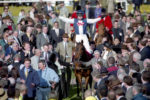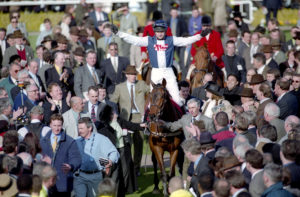With Paisley Park wearing the champion staying hurdler’s crown and De Rasher Counter winning this season’s Ladbrokes Trophy, you are reaping the rewards of all your hard work. Are you moving up a gear to a new level?
Since we have been at Bonita Racing Stables we have definitely moved up a gear. The facilities make it easier to train good horses and now we have some really nice ones working their way through. It is lovely seeing them in action on the big days, and importantly with a chance of winning.
We always aim to compete with the Hendersons and Nicholls, but we’ll never be able to match their numbers. When our horses are in the big races they are not there just to make up the numbers.
After paying €60,000 for Paisley Park you nearly lost him to colic after his first run. What makes him such a lovable character and talented racehorse?
He has a very nice temperament and absolutely loves polos! Before you tack him up every morning it is really funny to watch him doing his stretching exercises like a cat. He always loves what he’s doing, getting out there on the gallops and off he goes.
He is a good eater and enjoys his routine, so for me, he’s a joy to train. And, from Andrew Gemmell’s point of view, he’s a joy to own.
Every jumps trainer wants to win the Cheltenham Gold Cup. Will we see Paisley Park over fences next season?
I very much doubt it. He will continue down the hurdling route because he is so good over his hurdles. If you’re lucky enough, these top staying hurdlers make their mark in their division and tend to stay there. We hope he carries on as he is. Maybe we’ll try to win the Gold Cup with De Rasher Counter!
The aforementioned runners are strong staying types that handle testing ground. Is this the type of horse you love to train most of all?
Generally, the model of horse we buy is a store destined to become a staying chaser – with a bit of size and scope. At the sales I look at the individual, which has to be athletic, before I look at the page.
Gerry Hogan, a great friend of [husband] Barry’s, gave up riding to become a bloodstock agent and joined up with us when I started training and we’ve been together ever since.
The store sales have been our starting point as we don’t tend to have owners who pay hundreds of thousands of pounds. But when we have owners wanting to spend a bit more, we do go after the more expensive point-to-pointers.
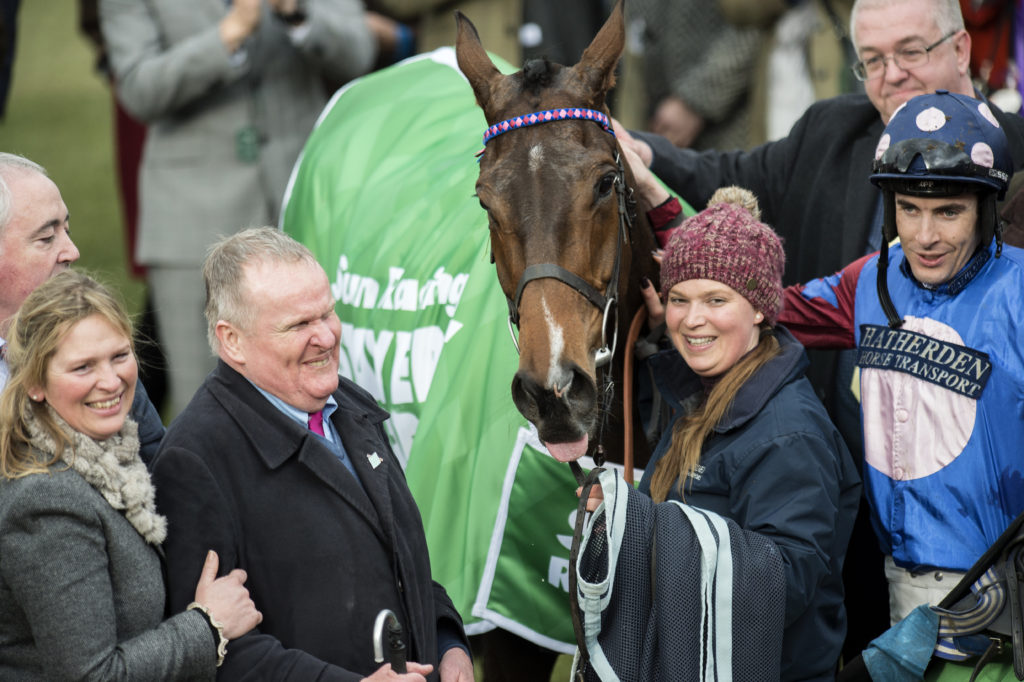
Lavelle and Andrew Gemmell (second left) celebrate after Paisley Park won the 2019 Stayers’ Hurdle at the Cheltenham Festival – Photo: George Selwyn
Andrew Gemmell, owner of Paisley Park and part-owner of De Rasher Counter, was voted Owner of the Year at both the ROA and HWPA Awards. He is an avid sports lover, despite being blind from birth. Does his enthusiasm rub off on others?
Andrew is the most amazing man for lots of reasons. His voice recognition is extraordinary. He visits the yard quite regularly and when different members of staff speak to him, he knows who they are.
He puts the name to the voice every time, which is incredible. The key is that Andrew absolutely loves the horses.
‘Paisley’ is all over Andrew when he visits him, which is one of the wonderful things about the horse. Andrew goes into his box, giving him pats and polos, and that means so much to us because all we want is for owners to be involved and to love and enjoy the horses.
Andrew makes it a great journey for all of us. It was as a result of his passion for sport, cricket in particular, that he came to us. He was at the Melbourne Cricket Ground and happened to find himself sitting next to my brother, Alex, who is editor of The Age in Melbourne.
Andrew announced he wanted to have a horse in training and Alex was quick to point out, ‘Would you believe, I’ve got just the person for you…’
Were you taking a big gamble in 2016 when you purchased the historic Bonita Racing Stables, near Marlborough?
It was a calculated gamble in that it was a big investment. We’d been renting in Andover for 18 years and that was dead money because it wasn’t our property and we had been investing in it as a business.
For us to go forward we needed to buy and Bonita came on the market. It was in need of modernisation and restoration. But the gallops are fantastic and we thought it was a once in a lifetime opportunity. We made friends with the bank and gave it a go.
It is a 300-acre plot with 150 acres of grass gallops. We put up a 20-box barn and a 24-box American barn, laid an all-weather gallop and built three houses. We also put in two walkers, a school and built an office. It was great because it was ours.
“All we want is for owners to be involved and to love and enjoy the horses”
Sir Gordon Richards was apprenticed to Martin Hartigan here before training here. He was followed by Bob Turnell and then Peter Makin, who sold Bonita to us.
Do you ever feel National Hunt racing is the poor relation compared to the Flat’s excesses in prize-money and ever-expanding all-weather fixtures?
I don’t think National Hunt racing is the poor relation. The Flat programme has been rolled out to include additional all-weather racing, in some parts being spread very thinly.
This hasn’t happened in the same way with jumping and, by not overdeveloping the programme, the result has been much healthier for us.
Look at the Cheltenham Festival and Aintree and how much money they generate through betting. It is important that we safeguard some of that for ourselves, keeping the money for National Hunt.
In many ways National Hunt racing is in a more robust position than Flat racing.
Does your husband, former jockey Barry Fenton, ride Paisley Park out every day? His feedback must be invaluable as the eight-year-old has a reputation for being a handful after working..
Paisley Park is a real handful after doing strong work and we are pleased when he is back in his box again. Barry was a very good jockey but had to retire early through bad luck with injuries.
Above all else, he is a horseman with a passion and great feel for horses. Having him riding Paisley every day is to both Paisley’s and my benefit.
He knows the horse inside out and I can only say I’m glad it’s him and not me riding Paisley when he’s coming home from the gallops. There’s no badness in Paisley at all. He’s just happy and full of exuberance.
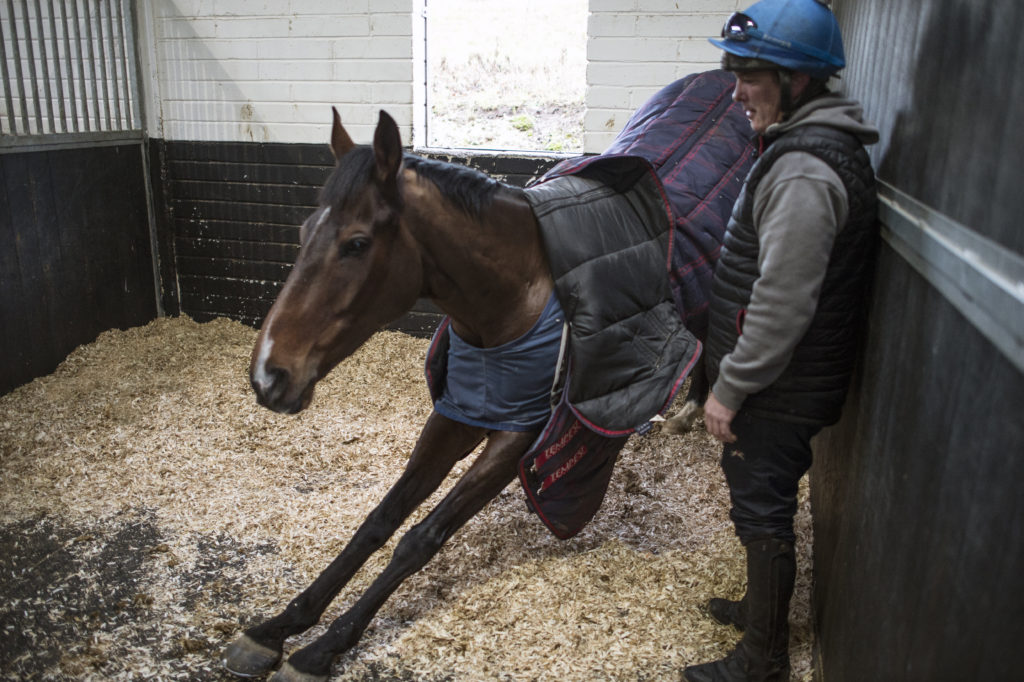
Paisley Park does his cat-like stretching before exercise – Photo: George Selwyn
You decided not to risk Paisley Park in Ascot’s extreme rain-sodden conditions before Christmas. How big a setback was that to his preparation for Cheltenham?
It was not a setback at all. Last season we were racing on goodish ground, which took far less out of him than if he’d been running on soft or heavy. Ascot before Christmas was only three weeks after a pretty hard race at Newbury.
The Ascot ground was unbelievably testing and because they raced the day before there were some false patches coming down the hill. We didn’t want to risk him.
How is it, husband and wife working closely together 24/7? Who’s the boss?
Most of the time it’s brilliant. We’re both strong minded about what we think, and that’s important. You can’t have it that one is a pushover because then you don’t really reason and think things through. Don’t get me wrong, there are times when I’m saying we should do this and Barry says we should do that.
Whatever the disagreement, I know I could not do the job without him because his feel for the horses, feedback and passion for the job is unbelievable.
When Barry’s riding around he has the vision of how we might improve the place. We bring different things to the table. Who’s the boss? That depends on which day of the week it is!
What are the plans for De Rasher Counter now and how far can he go as a chaser?
We always thought a lot of De Rasher Counter and after winning his novice at Newbury he just got stronger. Then after Uttoxeter we knew he was improving, his rating was right and we thought the Ladbrokes Trophy could be his race.
“I know I could not do the job without him”
It’s great when these plans work out. He’s a strong traveller and a very good jumper, those two assets make him quite a potent force.
De Rasher Counter has gone up to a mark of 160 and now we’ve got to see if he can take the next step to the Gold Cup or whether he remains just a very good handicapper.
The plan has been the Cotswold Chase on Cheltenham’s Trials day at the end of January. Depending on that it could be Gold Cup, Grand National or Scottish National.
He is a busy horse that loves his routine; once he’s racing all he’ll do is gallop for you. He’s a bit of an ‘odd-bod’ as he’ll stand in the middle of his stable and weave for no particular reason and every morning chuck his feed box out of his back window.
Is Aidan Coleman a potential champion jockey, and how big a talent is Ben Jones, the conditional rider successful on De Rasher Counter at Newbury?
One of the issues for Aidan becoming champion jockey is that he probably needs to get a prolific winning yard behind him. Dickie Johnson has Philip Hobbs and then the choice of three or four other yards, Harry Skelton has Dan Skelton, while Brian Hughes has got the north pretty much stitched up.
Aidan has the ability to be champion, but it’s about the size of the suppliers of the rides.
Ben Jones has great talent and a proper chance of being able to make it. He has the right grounding in the right yard with Philip Hobbs, who is a great educator of young jockeys.
Ben’s dad was a very good point-to-point jockey and has been instrumental in his career. Ben is starting from a great position with a good racing brain and feel for a horse. He’s got to keep getting better but it’s been a very good journey so far.
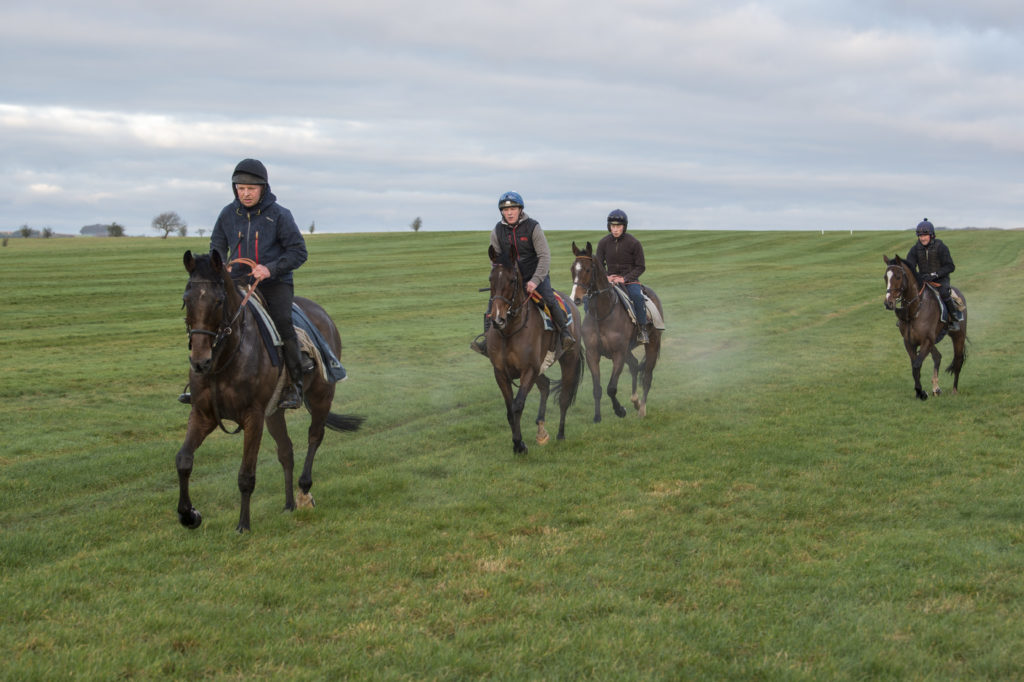
De Rasher Counter leads Paisley Park after working on the grass gallops at Lavelle’s stable – Photo: George Selwyn
As the new President of the National Trainers Federation, do you have a view on some trainers saying they will no longer employ Flat apprentices, after the BHA changed the rules on riding fee and prize-money percentages?
It’s not a matter in which National Hunt trainers have a huge involvement because we deal with conditional jockeys in a different way.
For Andrew Balding – someone who doesn’t necessarily put his head above the parapet very often and certainly not in a vocal way – to be so agitated there has to be a flaw in the argument. Also Richard Fahey, Richard Hannon and Mark Johnston the same. They are doing an awful lot to get the apprentices started.
My view is they are probably the people who are being punished, rather than the trainers who caused the problem in the first place by not looking after their apprentices properly. The BHA should really come down on those people, not on the trainers who were doing it right.
Early in your life you were inspired by the ‘Iron Lady’, Margaret Thatcher and even thought about going into politics yourself. You must be encouraged seeing so many women succeeding in racing. How tough do you need to be to compete with the men?
This sport is tough for all of us. It doesn’t make any difference which sex you are, you have to earn your respect. There are lots of different pressures that all trainers deal with and it isn’t about whether you’re male or female.
It’s the same with jockeys; you’re either a good jockey or not so good, it’s not about whether you’re male of female. If you work hard and think about what you’re doing you have a chance of making it whatever sex you are.
In the past there were people who broke new ground for women, like Jenny Pitman, and those who took things to a new level, like Henrietta Knight. But peoples’ mindset towards women had changed by then.
“You don’t get that buzz in many things in life”
I still follow politics and I think it is so important for us as an industry to have our voices heard in Westminster, to engage with our local MPs to put forward racing’s case and to be on the front foot.
One of your employees, Megan Lyth, is nominated in the newcomer category for the Godolphin Stud & Stable Staff Awards this month. How important is this event for the industry?
It is a great way of rewarding staff for going above and beyond what is expected of them. There may be only one winner but there are a huge number of people that work in the industry who are just as deserving.
The success of the prize winner filters down through the yard, as it has with Meg. She is passionate about the sport but wouldn’t have had any exposure to racing if it wasn’t for Racing To School, who initially took her on a day out to Sandown.
What is the worst part of being a trainer… and the best?
Without doubt injuries and fatalities are the worst. You spend so much time with the individuals it is heart-breaking when things go wrong.
It is very rewarding when you have a horse that isn’t the most talented, but tries its hardest and eventually gets its head in front.
When we had our magical weekend with Paisley Park and De Rasher Counter at Newbury all the staff went out to celebrate. That was special, seeing the joy in everyone. You don’t get that buzz in many things in life.


